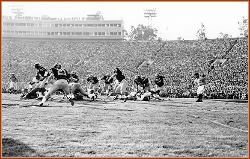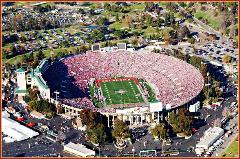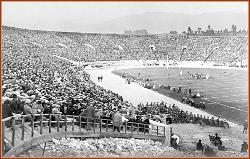







The Polo Grounds was the name given to four different
stadiums in New York City used by baseball's New York
Giants from 1883 until 1957, New York Metropolitans from
1883 until 1885, the New York Yankees from 1912 until
1922, and by the New York Mets in their first two seasons of
1962 and 1963. It also hosted the 1934 and 1942 Major
League Baseball All-Star Games.
The original Polo Grounds was built in the 1870s for the
sport of polo, thus accounting for its name. It was the only
one of the four structures that was actually used for polo.
The field was originally referred to in newspapers simply as
"the polo grounds", and over time this generic designation
became a proper name. It was converted to a baseball
stadium when leased by the New York Metropolitans in 1880.
The stadium was used jointly by the Giants and
Metropolitans from 1883 until 1885, and the name stuck for
each subsequent stadium of the Giants.
The fourth and final Polo Grounds, which the Giants used
until they moved to San Francisco after the 1957 season,
and which the Mets used until Shea Stadium was completed
in 1964, was the most famous, and is the one most people
mean when they refer to the Polo Grounds. The name "Polo
Grounds" did not actually appear prominently on any of the
stadiums, until the Mets posted it with a large sign in 1962.
The park was noted for its distinctive bathtub shape, with
very short distances to the left and right field walls, but an
unusually deep center field.
Left field also had an upper deck ("the short porch") which
extended out over the field (after its 1923 extension),
reducing the distance from 279 feet (85 meters) to about 250
feet (76 meters). That meant it was technically rather difficult
to hit a home run into the lower deck of the left field stands,
unless it was a line drive such as Bobby Thomson's famous
home run in 1951.
No player ever hit a fly ball that reached the 483-foot
(147-meter) distant center-field wall, which fronted a part of
the clubhouse which overhung the field. Given that
overhang, it was not inherently clear what the actual "home
run line" would have been in straightaway center. Some
sources listed the center field distance as 505, which
suggests that was where the true home run line would have
been, at the back of the clubhouse overhang. But if there
were any ground rules governing such a situation, they
never had to be applied.
Although the Polo Grounds had once been as celebrated as
Yankee Stadium now is, the end of the Polo Grounds'
existence was anticlimactic. Part of the problem was that the
stadium was not well maintained from the late 1940s onward;
while the Giants owned the stadium, they didn't own the
parcel where it stood. Also, the neighborhood around it had
already gone to seed. All of this combined to severely hold
down ticket sales, even when the Giants played well. In 1954,
for instance, the baseball Giants only drew 1.1 million fans
(compared to over 2 million for the Milwaukee Braves even
as they won the World Series.
The football Giants left for Yankee Stadium following the
1955 NFL season, and the baseball Giants' disastrous 1956
season (which they spent most of in last place before a
late-season surge moved them up to 6th) caused a further
drag on ticket sales. The Giants' 1956 attendance was less
than half of the figure for the Giants' World Series-winning
1954 season. That meant little to no money for stadium
upkeep.
Frustrated with the subsequent obsolescence and
dilapidated condition of the Polo Grounds and the inability to
secure a more modern stadium in the New York area, the
Giants announced on August 19, 1957 that they would move
following that season, after nearly three-quarters of a
century, to the West Coast.
The ballpark then sat largely vacant for the next three years, until the newly-formed Titans and then the newly-formed Mets moved in, using the
Polo Grounds as an interim home while Shea Stadium was being built. (As a 1962 baseball magazine noted, "The Mets will have to play in the
Polo Grounds, hardly the last word in 20th Century stadia.")
In the 1992 book The Gospel According to Casey, by Ira Berkow and Jim Kaplan, it is reported that in 1963, the Mets manager Casey Stengel,
who had bittersweet memories of his playing days at the grounds, had this to say to Tracy Stallard during a rough outing, to a pitcher whose
greatest claim to fame had been giving up Roger Maris' 61st homer in 1961: "At the end of this season, they're gonna tear this joint down. The
way you're pitching, the right field section will be gone already!"
The final incarnation of the stadium was indeed demolished in 1964, and a public housing project was erected on the site. Demolition of the Polo
Grounds began in April of that year with the same wrecking ball that had been used four years earlier on Ebbets Field. The wrecking crew wore
Giants jerseys and tipped their hard hats to the historic stadium as they began the dismantling. It took a crew of 60 workers more than four
months to level the structure.








